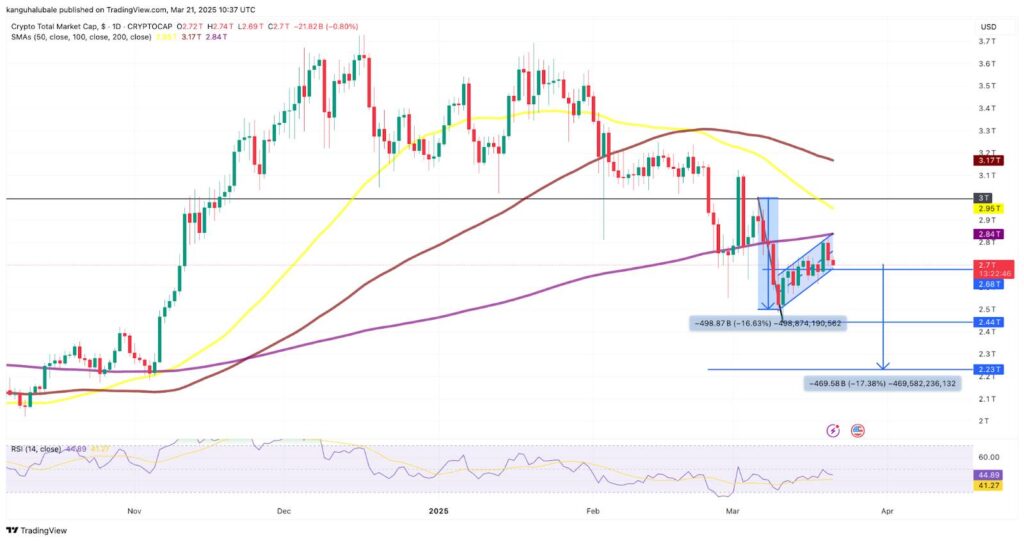The cryptocurrency market found itself in a downward spiral on March 21, experiencing a notable 2.5% decline in total market capitalization, now hovering around .75 trillion. This downturn has been attributed to a combination of factors, including the failure of Bitcoin to maintain its recent rally to ,000, which resulted in a loss of over 0 million in just 24 hours. Investors appear to be exercising caution amidst heightened risk aversion, a sentiment fueled by the recent performance of U.S. equities.
Bitcoin led the market retreat as traders took profits following a disappointing video address by former President Donald Trump at the Digital Asset Summit in New York. While Trump reaffirmed his support for cryptocurrency, many observers were left wanting for more substantive policy revelations. The mood in the market was further dampened by declines in other major cryptocurrencies like Ether, XRP, Solana, and Cardano, reflecting a broader trend as fear crept into investor sentiment.
“Investors are worried about taking on more risk in this market,” noted a market commentator, drawing parallels between recent declines in crypto assets and U.S. equity markets, where indices like the S&P 500 and Nasdaq have seen their own struggles.
The current state of the crypto market has triggered significant liquidation, totaling 5 million over the last day, with long positions facing the brunt of the impact. This suggests that many traders were overly optimistic about the market’s trajectory, leading to a precarious situation as bearish signals loom on the horizon. As the market grapples with what some analysts describe as a “bear flag” pattern, indicating potential further declines, caution is clearly the watchword.
As of now, the Fear & Greed Index sits at 27, reflecting a pervasive atmosphere of unease among crypto investors. With the market’s overall nervousness palpable, many are left wondering what the next steps may be for the beleaguered crypto landscape.
Current State of the Cryptocurrency Market – March 21
The cryptocurrency market has experienced a significant downturn, influenced by a range of factors that could impact investors’ strategies and decisions. Here are the key points to consider:
- Total Market Decline:
- The total market capitalization decreased by 2.5%, reaching approximately .75 trillion.
- Over 0 million was lost in just 24 hours as Bitcoin failed to maintain its rally.
- Market Influencers:
- US President Donald Trump’s speech at the Digital Asset Summit lacked new policy announcements, causing disappointment among investors.
- Bitcoin’s price retraction from ,000 led many traders to book profits, contributing to the overall market slump.
- Technical Indicators:
- The market is showing signs of a bearish continuation pattern (bear flag), indicating potential further declines.
- Critical support levels are being tested, and declining below these could lead to losses of up to 32%.
- Equity Market Correlation:
- The cryptocurrency market is increasingly correlated with US equities, reflecting a broader risk-off sentiment among investors.
- Major US indices like the S&P 500 and Nasdaq have shown declines, affecting market confidence.
- Investor Sentiment:
- The Fear & Greed Index is currently at 27, indicating a high level of fear in the market.
- Cautious trading volumes have also been noted, reflecting overall nervousness among traders.
“Investors are worried about taking on more risk in this market.” – The Kobeissi Letter
Understanding these factors can affect how investors approach their strategies, manage risk, and potentially identify future opportunities in the cryptocurrency space.
March 2023 Crypto Market Tumbles: Analyzing the Impact and Implications
On March 21, the cryptocurrency market faced a notable downturn, with a 2.5% dip in total market capitalization, reducing it to approximately .75 trillion. This decline holds significant implications, particularly when juxtaposed with recent market behaviors and sentiments.
According to market analysts, several factors have converged to drive prices down. Bitcoin’s inability to maintain a high of ,000 was a pivotal moment, leading to a substantial profit-taking wave from investors. This situation starkly contrasts with the euphoria seen throughout the recent rally, demonstrating how quickly market sentiment can flip from bullish to bearish. It showcases the vulnerability of cryptocurrencies to economic uncertainties, especially in a correlated market environment where fears surrounding US equities are prevalent. Unlike other traditional markets or assets that sometimes exhibit resilience, cryptocurrencies seem tightly tethered to equities, amplifying sell-off reactions.
The drop was exacerbated by the financial pressure on leveraged positions, leading to significant liquidations—5 million in leveraged trades were wiped out in the past 24 hours alone. This highlights a major disadvantage within the crypto trading space, where over-leveraging can lead to rapid losses, amplifying market volatility. Conversely, a few advantageous aspects are worth mentioning: although some investors are in a risk-off mode, the volatile nature of cryptocurrency can present opportunities for agile traders who thrive in challenging environments.
The recent performance of large-cap cryptocurrencies like Ether, XRP, Solana, and Cardano reflects a wider struggle. For instance, Ether’s decline below the ,000 mark and the notable losses for XRP and ADA underline a saturation of selling pressure. This trend could benefit short-sellers or those holding stablecoins, as they capitalize on price depreciation, while those heavily invested in long positions face significant challenges. Furthermore, analysts suggest the prevailing bearish technical patterns could inhibit new investors seeking to enter the market, imposing barriers that further deter participation.
Meanwhile, the market’s response to external events, such as former President Trump’s speech at the Digital Asset Summit, indicates that the crypto community remains highly sensitive to regulatory signals. The lack of actionable policy announcements post-speech has only added to the precarious sentiment, suggesting that players in the crypto space should stay vigilant about regulatory developments. While the speech itself did not present new risks, the missed expectations could result in investors erring on the side of caution going forward.
Overall, the current market dynamics suggest a complicated web of opportunities and threats. Besides the speculative mindset that often accompanies cryptocurrency trading, the ongoing fear of recession and high correlation with traditional stocks could amplify the challenges for those looking to navigate this tumultuous landscape.















